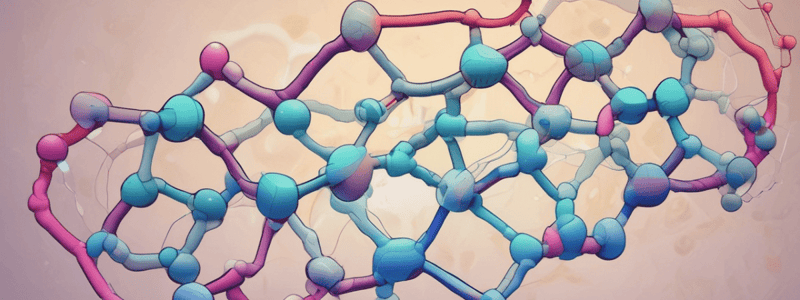Podcast
Questions and Answers
What is the approximate percentage of protein sequences in the Protein Data Bank that contain the p-helix structure?
What is the approximate percentage of protein sequences in the Protein Data Bank that contain the p-helix structure?
- 50%
- 15% (correct)
- 5%
- 25%
What is the main reason for the formation of a p-helix structure in a protein?
What is the main reason for the formation of a p-helix structure in a protein?
- Insertion of an amino acid into an a-helix (correct)
- Mutations in the gene encoding the protein
- Deletion of an amino acid from a b-sheet
- Post-translational modification of the protein
What is the characteristic shape of fibrous proteins?
What is the characteristic shape of fibrous proteins?
- Spherical
- Filamentous (correct)
- Globular
- Pentagonal
What is the main function of fibrous proteins in animal cells and tissues?
What is the main function of fibrous proteins in animal cells and tissues?
What is the characteristic secondary structure of a-keratins?
What is the characteristic secondary structure of a-keratins?
What is the bulge in the helical structure of a protein caused by?
What is the bulge in the helical structure of a protein caused by?
What is the function of intermediate filament proteins?
What is the function of intermediate filament proteins?
What is the relationship between the amino acid sequence of a fibrous protein and its secondary structure?
What is the relationship between the amino acid sequence of a fibrous protein and its secondary structure?
What is the reason why arginine is the most basic amino acid?
What is the reason why arginine is the most basic amino acid?
At pH 7, which amino acid residues typically carry negative charges?
At pH 7, which amino acid residues typically carry negative charges?
What is the characteristic of the side chains of asparagine and glutamine?
What is the characteristic of the side chains of asparagine and glutamine?
What is the result of post-translational modification of amino acids?
What is the result of post-translational modification of amino acids?
What is the bond formed between the α-carboxylic acid group and the α-amino group?
What is the bond formed between the α-carboxylic acid group and the α-amino group?
What is the term for a peptide composed of 2 amino acids?
What is the term for a peptide composed of 2 amino acids?
What is formed on the ends of a peptide after amide bond formation?
What is formed on the ends of a peptide after amide bond formation?
What is the characteristic of the amino acids asparagine and glutamine in terms of their location in a protein?
What is the characteristic of the amino acids asparagine and glutamine in terms of their location in a protein?
What is the primary characteristic of the proline side chain?
What is the primary characteristic of the proline side chain?
Which amino acids are fairly hydrophobic but display more hydrophilic character than their aliphatic analogs?
Which amino acids are fairly hydrophobic but display more hydrophilic character than their aliphatic analogs?
What is the pKa of the cysteine side chain?
What is the pKa of the cysteine side chain?
What is the product of the oxidation of two cysteine side chains?
What is the product of the oxidation of two cysteine side chains?
Which amino acid is one of the most hydrophobic?
Which amino acid is one of the most hydrophobic?
What is the characteristic of the aromatic amino acids?
What is the characteristic of the aromatic amino acids?
What is the pKa of lysine?
What is the pKa of lysine?
What is the characteristic of lysine and arginine under physiological conditions?
What is the characteristic of lysine and arginine under physiological conditions?
What is the decisive factor for the overall free energy change for folding to be negative?
What is the decisive factor for the overall free energy change for folding to be negative?
Which of the following interactions contributes to the favorable enthalpy change during protein folding?
Which of the following interactions contributes to the favorable enthalpy change during protein folding?
Why are disulfide bonds relatively rare in proteins?
Why are disulfide bonds relatively rare in proteins?
What is the primary reason why disulfide bonds are found primarily in proteins that are exported from cells?
What is the primary reason why disulfide bonds are found primarily in proteins that are exported from cells?
What is the characteristic of the folding of globular proteins from their denatured conformations?
What is the characteristic of the folding of globular proteins from their denatured conformations?
What is the role of intermediate states in protein folding?
What is the role of intermediate states in protein folding?
Why does the unfavorable conformational entropy change favor the unfolded state?
Why does the unfavorable conformational entropy change favor the unfolded state?
What is the role of the favorable entropy change in protein folding?
What is the role of the favorable entropy change in protein folding?
What does the 'U' state represent in the folding pathway for a protein?
What does the 'U' state represent in the folding pathway for a protein?
What is the direction of the protein folding trajectory in the 'energy landscape' model?
What is the direction of the protein folding trajectory in the 'energy landscape' model?
What is the primary function of molecular chaperones?
What is the primary function of molecular chaperones?
What is the GroEL-GroES complex?
What is the GroEL-GroES complex?
What is the consequence of protein misfolding?
What is the consequence of protein misfolding?
What can delay protein folding?
What can delay protein folding?
What are 'on-pathway' intermediate states?
What are 'on-pathway' intermediate states?
What is an 'off-pathway' state?
What is an 'off-pathway' state?
Flashcards are hidden until you start studying
Study Notes
Amino Acid Side Chains
- Proline has a primarily aliphatic character, but is frequently found on protein surfaces due to its unique structural constraints.
- The rigid ring of proline is well-suited to protein sites where the protein must fold back on itself (turns).
- Methionine and tyrosine are fairly hydrophobic, but display more hydrophilic character than their aliphatic analogs.
- The –OH group of serine and the –SH group of cysteine are good nucleophiles and often play key roles in enzyme activity.
Cysteine
- The side chain has a pKa = 8.3, so it can ionize at moderately high pH.
- The oxidation of two cysteine side chains yields a disulfide bond, producing cystine.
Hydrophobic Amino Acids
- Phenylalanine is one of the most hydrophobic amino acids.
- Tyrosine and tryptophan have some hydrophobic character, but it is tempered by the polar groups in their side chains.
Aromatic Amino Acids
- Aromatic amino acids absorb light in the near-ultraviolet region of the spectrum.
- This characteristic is frequently used for protein detection and/or quantitation by measuring absorption at 280 nm.
Basic Amino Acids
- Lysine (pKa = 10.0) and arginine (pKa = 12.5) are the most basic amino acids.
- Their side chains are almost always positively charged under physiological conditions.
- The guanidino group of arginine makes it the most basic amino acid due to resonance stabilization of the protonated side chain.
Acidic Amino Acids
- Aspartic acid (pKa = 3.9) and glutamic acid (pKa = 4.2) typically carry negative charges at pH 7.
- These amino acid residues are often referred to as aspartate and glutamate (conjugate bases rather than acids).
- Asparagine and glutamine have uncharged polar side chains, and are hydrophilic, tending to be on the surface of a protein molecule.
Post-translational Modification
- Amino acids can undergo post-translational modification, resulting in modified amino acids with unique properties.
Peptides and the Peptide Bond
- Amino acids can be covalently linked together by formation of an amide bond between the α-carboxylic acid group on one amino acid and the α-amino group on another.
- This bond is often referred to as a peptide bond, and the products formed by such a linkage are called peptides.
- A peptide composed of 2 amino acids is called a dipeptide, and a peptide composed of 4 amino acids is called a tetrapeptide.
- The amide bond formation leaves an amino group available on one end of the tetrapeptide and a carboxylate group on the other, called the N-terminus and C-terminus, respectively.
Secondary Structure
- The p-helix is a type of secondary structure found in ~15% of protein sequences in the Protein Data Bank.
- It is also known as an “α-bulge” or “p-bulge” and occurs only once in any given sequence.
- The p-helix conformation is created by the insertion of an amino acid into an α-helix, resulting in a bulge in the helical structure.
Fibrous Proteins
- Fibrous proteins have a filamentous, or elongated, form.
- They play structural roles in animal cells and tissues and include the major proteins of skin and connective tissue and of animal fibers like hair and silk.
- The amino acid sequence of each of these proteins favors a particular kind of secondary structure, which confers on each protein a particular set of mechanical properties.
Factors Determining Secondary and Tertiary Structure
- The stability of the folded structure of a globular protein depends on the interplay of three factors:
- Unfavorable conformational entropy change, which favors the unfolded state.
- Favorable enthalpy contribution arising from intramolecular interactions.
- Favorable entropy change arising from the burying of hydrophobic groups within the molecule.
Dynamics of Globular Protein Structure
- The folding of globular proteins from their denatured conformations is a remarkably rapid process, often complete in less than a second.
- Protein folding is not a completely random search through a vast conformational space, but rather takes place through a series of intermediate states.
- The “energy landscape” model suggests that the trajectory of protein folding is “downhill”—it proceeds with a decrease in free energy.
- Chaperones, such as the GroEL-GroES chaperonin, can help facilitate proper protein folding by preventing improper folding and aggregation.
- Protein misfolding is the basis for several diseases, including Alzheimer’s disease and Parkinson’s disease.
Studying That Suits You
Use AI to generate personalized quizzes and flashcards to suit your learning preferences.




